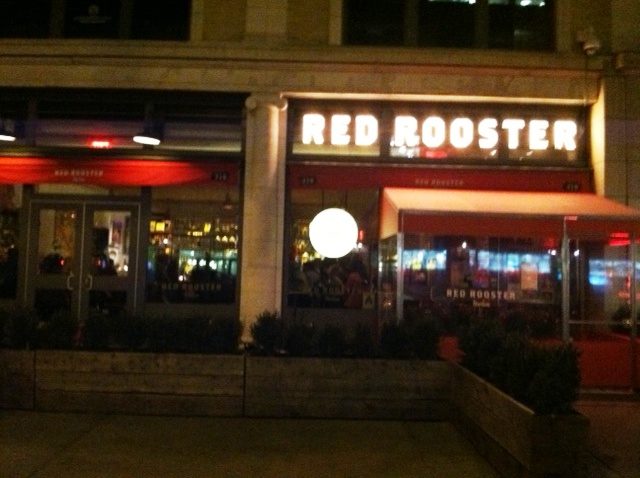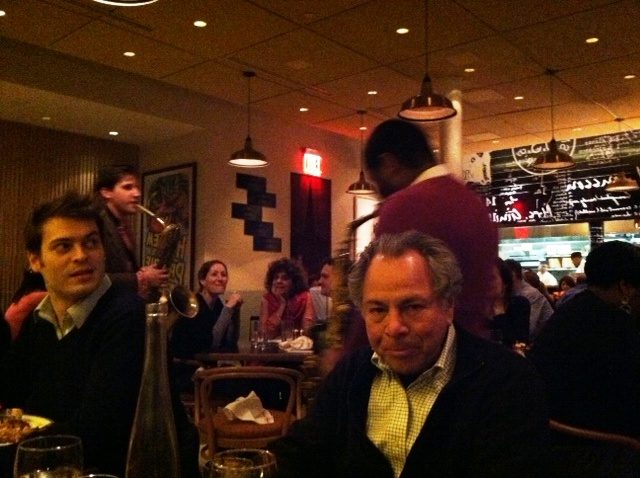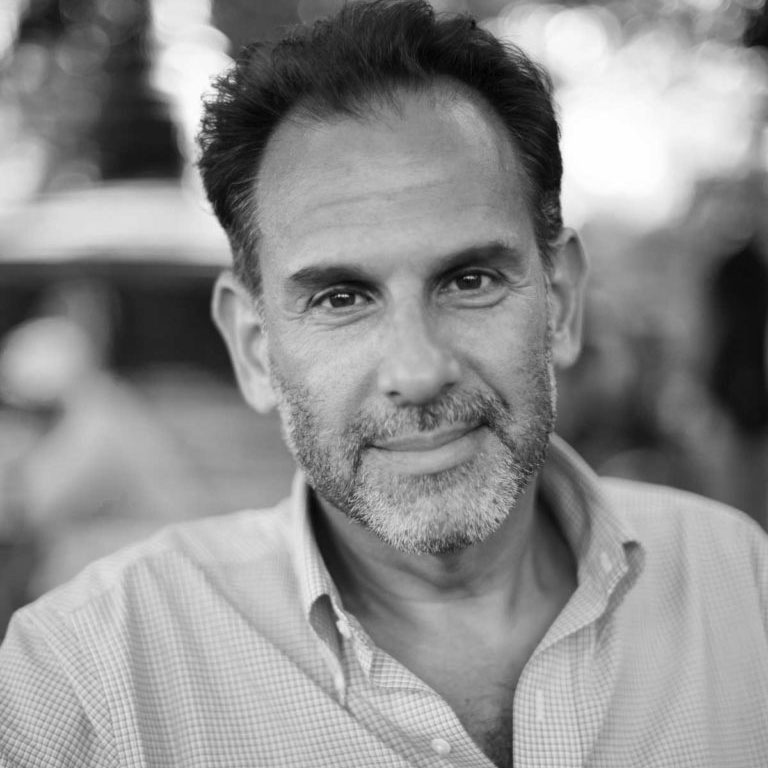A Visit to Red Rooster Harlem, and Entirely Too Brief Encounter with Marcus Samuelsson
More than anything, Red Rooster Harlem reminded me of the sand.
About ten years ago, I asked Marcus Samuelsson, then the chef of Restaurant Aquavit, if he’d grant me an interview for use in a proposal for a book I had in mind. He happily obliged, inviting me to the one-bedroom apartment in the West 40s where he lived at the time.
I had first met Marcus during my short, unhappy life as a restaurant publicist in the 1990s. Aquavit‘s owner, Hakan Swan, had recently appointed him, then just 24, the chef, then hired the agency for which I worked to rep the place. Marcus’ celebrity is such that nobody thinks anything of his name anymore; his story–orphaned in Ethiopia at age 3, adopted by a Swedish family thereafter–has become common knowledge. But when he first turned up at Aquavit in Midtown Manhattan, he was incongruity personified: a skinny black kid with a Swedish handle cooking Scandinavian cuisine in a townhouse once occupied by Nelson Rockefeller. Customers who didn’t read the food section flirted with whiplash as they panned along with him whenever he passed through the dining room and it slowly dawned on them: “That’s the chef!”
I’d say that Marcus and I came up together except that it’s a pretty absurd statement given how far he’s ascended. But that’s how it felt at the time, and still does in retrospect, in part because he was so supportive of my own trajectory. It’s not easy making the switch from publicist to professional writer; generally speaking, people want to keep you in whatever box you shipped in. But it can be done; just ask Peter “Lucky Peach” Meehan. When I was first going for it, Marcus was immensely and uncommonly supportive. After my first foray into professional writing, the next few times I saw him, he’d flash a warm grin and say, “You’re a writer now, Andrew.”
He was also always eager to share what he was up to. Years after we stopped working together, he rang me up and asked me to come in and taste from a new menu. (He had just introduced, and was incredibly excited about, a foie gras ganache, a decadent savory spin on the molten chocolate cake first cooked by Michel Bras, then famously adopted by Jean-Georges Vongerichten here in New York. Years later, Marcus made it on the finale of Top Chef Masters, which he won.) When I asked him if he’d give me a story for the book Don’t Try This at Home, he had just relocated Aquavit to its new space on 55th Street, and insisted that we do the interview over dinner.
But back to that apartment in the West 40s: After interviewing in his living room, he told me to follow him into the kitchen. It was a narrow and unremarkable New York City apartment galley with a long counter on one side and appliances on the other. Why did I need to see this? I wondered. But then he pointed down to the ground, where his bare feet were half buried in sand. The entire floor of kitchen was covered with the stuff.
He explained to me that the sand was there to loosen him up, to keep him from feeling too constrained by convention or dogma, an invitation to himself to stir things up when he cooked. He then pointed out the colorful little murals he’d created on the wall using various spices he’d mixed with (I assume) water to fashion a kind of paint. “Why not?” he said, smiling big.
How things have changed for Marcus since those days. Not only was he the victor on Top Chef Masters, but he’s become a ubiquitous presence on cooking shows, has an autobiography coming out, and is an in-demand advertising pitchman. Plain and simple: He’s a star.
Marcus’ primary professional home now is Red Rooster Harlem, where I had plans for dinner last week with Jimmy Bradley and Steven Eckler of The Red Cat and The Harrison. We met outside, and headed in where we were greeted by David Pogrebin, a young front of the house veteran whom I first met at Cascabel (now the home of Osteria Morini) in the 1990s, then reconnected with when he worked at Jean-Georges in the early 2000s.

Red Rooster Harlem, as seen from the street.
We were seated, ordered drinks. Ten minutes into our stay, Marcus breezed into the dining room, pulled a chair up to our table, and sat. We talked for a bit, then he asked if he could give us a tour of the restaurant. He walked us up to the bar, jam packed on a Monday night, and pointed over the crowd to a band jamming in the corner.
“On Monday nights, waiters perform!” he shouted over the din.
Then he took us downstairs and gave us a sneak peek at the renovations being done on the sizable space below . We were just hanging, so it wouldn’t be right to spill any of the details, but it was terribly impressive and exciting, and he conveyed his plans with that trademark enthusiasm. At one point, referring to a slightly unconventional touch he had in mind he said, “People keep trying to put rules in front of us and we keep going around them.” He laughed, joyously, at the idea of anybody silly and provincial enough to apply rules to something as personal as a bar, or a restaurant.
Upstairs, on the way back to our table, Marcus leaned into my ear and said, “You know, The Red Cat was a big inspiration to me. I told Jimmy that. The way it feels when you walk in there, the way it fits into the neighborhood. It just feels right.” As he pulled ahead of me, and I watched him glide through the space, heads turning after him as they always have, it occurred to me how unusual it was that, unlike just about every toque I know, Marcus didn’t bother with the pretense of donning a chef’s jacket for his pass through the dining room. It’s nothing more or less than an honest gesture: He wasn’t cooking, so he was in his street clothes, although it must be said that Marcus’ street clothes are fashionable enough for a front-row seat at the Grammys.
In just a few minutes, I had been reminded of all the things I used to appreciate about this guy: the sincerity, the generosity of spirit, the willingness to acknowledge a bit of inspiration, the zest for life and for work. It also occurred to me that his early support of my dream was an extension of his own “no rules” philosophy; he sure as hell wasn’t going to be put into a cubby hole, why should anybody else?
He visited with us for a little while longer, then somebody tapped him on the shoulder, he turned around, and that was that: he was gobbled up by the scene, greeting one table, then another and another until suddenly, he was at the other side of the room, and then, he was gone.
Jimmy, Steve, and I sat and ate, both what we’d ordered and quite a bit that we hadn’t. The food was delish: I had Dirty Rice and Shrimp and “Helga’s Meatballs,” a Swedish dish complete with lingonberries and dill-stewed potatoes. I also got to taste gravlax,a peanut soup (with surprising bits of avocado), jerk bacon and eggs, fried Mayan shrimp, and much more.

Musicians roam the dining room at Red Rooster Harlem
It was a fun night: At one point, the saxophone and horn players from up front came around the bar and into the dining room, passing right by our table. I thought again of that sandy kitchen: Why not let the waiters jam once a week? Why confine the musicians to the bar just because that’s where the performance area was? Why not serve Swedish meatballs alongside jerk bacon and eggs and fried Mayan shrimp?
On the long subway ride home to Brooklyn, I found myself thinking of the old days, and how badly I’d fallen out of touch with Marcus over the past five or six years. Why did that happen? I wondered. The obvious answer would have been that he got way goddamn famous during that time. But Marcus isn’t the kind of guy to let something like that go to his head, and I realized that it was me who had drifted away. I hadn’t made it to his last few ventures, hadn’t reciprocated for all that generosity of spirit and inclusion he’d shown me. I’d never even finished that book proposal.
Oh, sure, I had my reasons. The same reasons many of us have in New York: work, kids, life. An abundance of ambition and shortage of time. Some people come with us on our journeys, others–before we know it–slip away.
Sometimes, I manage to keep it together: Red Rooster was my second dinner this year with Jimmy and Steve, and we’re already planning a third. We used to dine together regularly, then didn’t for a time. But I want to see these guys more and guess they’ve decided the same about me. This is how it should be–what life is all about, if you will–but I’m sorry to say it’s become the exception rather than the rule. For every Jimmy, for every Steve, there are ten guys I’ve fallen out of touch with, and vice versa.
I got back to Carroll Gardens at about 11pm. Climbing up out of the subway station toward moonlight drenched Smith Street, I heard somebody call my name.
It was a neighbor, and relatively new friend. He’s a brave man: In his 40s, he switched careers last year to pursue a film industry dream. We talked for a moment, then went our separate ways. On the short walk home, thoughts of my own transitional days top of mind, I scolded myself for not supporting him enough. I resolved to call him up, buy him a drink, give him some precious encouragement.
It’s a week later. I still haven’t found the time.
And the beat goes on.
– Andrew


